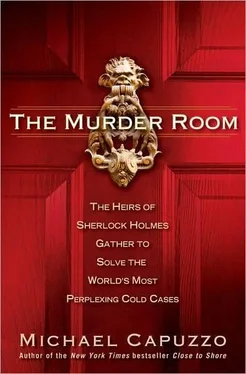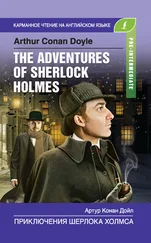“Richard’s profile was right on the money,” Fleisher said with pride, as Walter smiled graciously, and Bender’s face fell. “Way to go, Richard.”
The killer was a macho ex-con known for carrying weapons, and he’d struck Weaver in the head, just as Walter predicted. But the killer wasn’t Robert Updegrove, the ex-con who found the grave and Walter said also fit the profile.
“I knew it wasn’t Updegrove!” Bender said. “Rich, you’re not always right.”
Walter rolled his eyes, wondering how to fend off the coming attack. For once, he wished his partner would be satisfied with the remarkable role his forensic art had played in bringing a killer to justice.
“Frank, you’re going to push me only so far.”
The Vidocq Society had lost track of the case in the two years since Bender completed his facial reconstruction. The department had transmitted the image widely to police departments and the media, with no results. Keith Hall, the officer who led the investigation, had left the small department to become a detective with the Onondaga County sheriff ’s office, taking his passion with him. The case had gone nowhere.
Then in September 2001, Thaddeus Maine, a bright, young Manlius officer, was ordered by his commander to throw out hopeless cold-case files, including that of the Girl with the Missing Face.
But as Maine looked over the old files, he was intrigued. He had guarded the grave five years ago, and had hung a photograph of Bender’s bust on his office wall. It was still there, staring down at him, a coffee-colored woman with a broad nose and lips, close-set eyes, and a high forehead fringed with short curly hair. He saw decency, and a world of pain, in those eyes. They chilled him. He liked the woman, whoever she was, and felt sorry for her.
Maine decided to make a few phone calls. A respected investigator, he had been given permission to look into any worthwhile cases one last time before shredding them, but he had been asked to do it quietly. He began to interview residents of nearby farms, asking about itinerant laborers who had passed through the area more than ten years before. Hundreds of phone calls later, he came across the name of Roland Patnode, an American Indian carpenter from Massena, New York, on the Canadian border who had rented a cabin on a farm within sight of the grave-the same cabin Updegrove rented years later.
Patnode quickly became Maine ’s chief person of interest. The six-foot-four, 230-pound man, a great high school athlete who’d earned a wrestling scholarship to college, had served time for a 1986 murder committed within the likely range of time the Manlius victim had disappeared. While working as a carpenter in Syracuse, Patnode was convicted of murdering a transvestite prostitute. At the July 1987 trial, Patnode claimed he’d stabbed David McLaughlin, twenty-two years old, to death in the throat after discovering the slim figure in a dress giving him oral sex was “not a female, it was a man.”
The jury, apparently sympathetic to his lawyer’s claims that a “sleazy homosexual transvestite… duped this poor country boy,” found Patnode innocent of murder and convicted him of man-slaughter. After serving only four years in prison, he’d violated parole and fled to Canada. Rochester police, Maine learned, considered Patnode a possible suspect in the disappearance of several prostitutes, including a missing person from 1986 named Lorean Quincy Weaver.
Following routine procedure, Maine got a copy of Weaver’s mug shot from Rochester. As he studied the young black woman’s short hair, wide mouth, and soft eyes, he literally felt a jolt running through him. While the faces were not identical, he felt certain it was the same young woman who was staring at him from the bust on the wall. He ran down the hall to two superior officers with the photographs and his gut feeling; they all felt the same thing. When they “compared the photo to the bust prepared by Mr. Bender,” a police report later said, “we were certain we had identified the victim.”
It was Lorean Quincy Weaver, twenty-six years old; when her mother saw a photo of the bust she said, “I always wondered what happened to Lorean.” DNA from Lorean’s relatives matched DNA taken from bone marrow in the scattered remains. Police were amazed that Bender had captured her personality in the bust, as well. Lorean, they learned, was a sweet young woman who never wanted to be a prostitute but started as young as fourteen, and never made much money. Her story was the rare one that touched the cops. “She was unlucky,” said Manlius Sergeant William Becker, “right up to getting in the car with the wrong man.” She had last been seen alive getting into a pickup truck in late 1986 with Patnode.
In February 2002, two Manlius detectives went to interview Patnode at the Downstate Correctional Facility in Fishkill about the murder of Weaver. Patnode, thirty-nine, had just been picked up on his parole violation from an Indian reservation in Canada, expecting to serve only a few months on the minor infraction. Then the interrogators put Weaver’s picture in front of him, and his eyes filled with tears. “She’s my ghost,” he said. He confessed to the murder twelve minutes into the interview.
Patnode admitted to killing her in late August or early September 1986. As Walter reviewed the confession, he saw that the crime was a “classic” fit for the profile. Patnode went looking for a prostitute after drinking in a downtown bar, he told detectives, and picked up Weaver and paid her twenty dollars for a sexual encounter in his pickup truck. When that was done, he told her he was breaking up with his girlfriend and wanted a second, more extended sexual encounter, but Weaver objected. Patnode began to force her and she slapped him. He slapped her back hard, four or five times in the face, and then began punching her. She drew a small knife and cut him in self-defense.
“She kept trying to fight me off, but I was much bigger than her,” Patnode said. “I then grabbed her around the neck with both of my hands and started squeezing. I couldn’t stop, and I was feeling so angry. She was trying to get out of my grip, and I kept squeezing her neck. I don’t remember how long I squeezed her neck for, but she slowly stopped moving, and she went limp.”
Patnode began to drive home, wondering what to do with the body, when suddenly Weaver moaned and tried to sit up. Patnode said he grabbed a framing hammer from the center console of his truck and struck her on the head four or five times until she stopped moving. In a three-page confession, he also admitted to sexually violating the corpse before burying her at the edge of a field off Salt Springs Road in Manlius.
The Manlius detectives realized that Richard Walter’s profile was correct in another respect-Patnode was a serial killer. It was a month after killing Weaver on October 1 that Patnode picked up transvestite prostitute McLaughlin and killed him, and he was a likely suspect in other murders.
Weaver’s body went undetected for eleven years. Patnode had all but gotten away with two murders, and might never have been brought to justice if he’d buried Weaver deeper than eleven inches-and if Bender hadn’t been willing “to take a long shot rather than no shot at all.” In October 2002, Patnode was convicted of the murder. As Patnode wept and apologized, Judge Anthony Aloi sentenced him to the maximum penalty of twenty-five years to life in state prison for committing “an unbelievably heinous, atrocious, and cruel act.”
“Lorean Weaver may have been your ghost, Mr. Patnode, but she was a human being. She was a daughter. She was a sister. She was a mother. She was a memory to her family. She was a crack in their broken hearts for all those years… Mr. Patnode,” he said, “you should remain in prison for the rest of your life.”
Читать дальше












